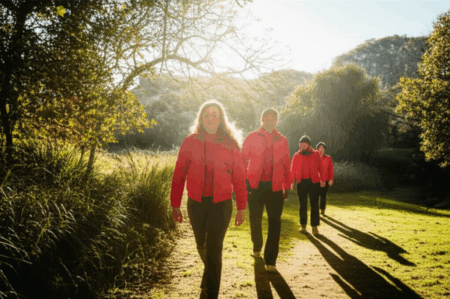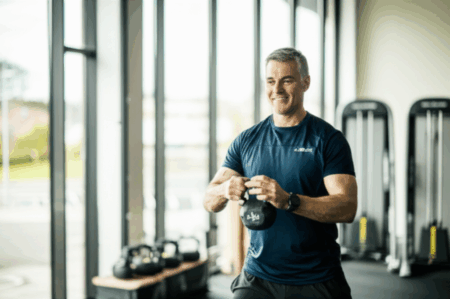Olympic gold medalist Sally Gunnell has transitioned from pushing her body to its athletic limits to embracing a fitness routine focused on longevity and overall “life performance.” At 58, Gunnell is an advocate for adapting exercise regimens as we age, emphasizing consistency and sustainability over high-intensity workouts. Here’s what you can learn from her approach to staying strong, active, and unstoppable.
The Evolution of an Olympian’s Workout
Gunnell, who once dominated the track as the first 400-meter hurdler to simultaneously hold Olympic, World, European, and Commonwealth titles, now prioritizes exercises that support her physical and mental well-being in midlife. Her shift reflects a broader understanding of how our fitness needs change as we age.
From Gold Medals to Managing Menopause
Gunnell has openly discussed the challenges of menopause and how it affected her ability to exercise. Recognizing the importance of movement for mental health, she adapted her routine to manage symptoms and maintain an active lifestyle. This involves a balanced approach that includes strength training, cardio, and recovery techniques.
Consistency Over Intensity
A key principle of Gunnell’s current routine is consistency rather than intensity. While she used to focus on running and high-intensity training, she now incorporates strength training three to four times a week. This shift acknowledges the critical role of strength training in maintaining muscle mass and bone density, which naturally decline during menopause and aging.
Gunnell’s Exercise Essentials for Longevity
Gunnell’s routine incorporates several key elements that contribute to her overall health and well-being. These include strength training, cardio, and recovery practices.
Strength Training: Building a Strong Foundation
Strength training is a cornerstone of Gunnell’s current fitness regime. She emphasizes its importance for maintaining muscle mass, bone density, and overall strength as we age. The NHS recommends incorporating strength-based exercises at least twice a week, using dumbbells, resistance bands, or bodyweight.
Benefits of Strength Training:
- Improved energy levels
- Better posture
- Positive impact on mental health
Gunnell notes that strength training makes her feel strong, which is crucial for her mental well-being.
Cardio: Keeping the Heart Healthy
While Gunnell has reduced the intensity of her cardio workouts, she still includes activities like running and bike riding in her routine. These exercises help maintain cardiovascular health without putting excessive strain on the body.
Key Considerations for Cardio:
- Listen to your body and adjust intensity as needed.
- Focus on keeping your heart healthy without pushing to the max.
- Incorporate activities you enjoy to make exercise sustainable.
Even a light walk each day can contribute to overall cardiovascular health and well-being.
Recovery: The Key to Longevity
Recovery is a vital component of Gunnell’s exercise routine, especially as she ages. She incorporates breath work, yoga, and “me times” to promote relaxation and reduce stress.
Benefits of Recovery Practices:
- Reduced risk of injury
- Improved sleep quality
- Enhanced mental well-being
Gunnell emphasizes that recovery is often the hardest part of her routine, as she tends to be “all go.” However, she recognizes its importance for long-term health and sustainability.
Simple Exercises for “Life Performance”
While Gunnell hasn’t explicitly detailed a specific workout routine for “life performance,” her overall approach emphasizes functional fitness and exercises that support everyday activities. Here’s a sample routine inspired by her principles:
Warm-up (5-10 minutes):
- Light cardio, such as walking or marching in place
- Dynamic stretching, including arm circles, leg swings, and torso twists
Strength Training (2-3 times per week):
- Squats: 3 sets of 10-12 repetitions (bodyweight or with light dumbbells)
- Push-ups: 3 sets of as many repetitions as possible (modify on knees if needed)
- Lunges: 3 sets of 10-12 repetitions per leg (bodyweight or with light dumbbells)
- Rows: 3 sets of 10-12 repetitions (using resistance bands or dumbbells)
- Plank: 3 sets, holding for 30-60 seconds
Cardio (3-5 times per week):
- Brisk walking: 30-60 minutes
- Cycling: 30-60 minutes
- Running: 20-45 minutes (adjust intensity as needed)
Cool-down (5-10 minutes):
- Static stretching, holding each stretch for 30 seconds (e.g., hamstring stretch, quad stretch, calf stretch)
- Deep breathing exercises
Additional Tips from Sally Gunnell:
- Listen to Your Body: Pay attention to any pain or discomfort and adjust your routine accordingly.
- Stay Active Daily: Incorporate movement into your daily life, even if it’s just a light walk or taking the stairs.
- Make It Enjoyable: Choose activities you enjoy to make exercise a sustainable part of your lifestyle.
- Focus on Overall Well-being: Combine exercise with a balanced diet, sufficient sleep, and stress-reduction techniques.
- Don’t Be Afraid to Lift Weights: Strength training is crucial for maintaining muscle mass and bone density as you age.
- Get Back to Basics: Sometimes, the simplest exercises are the most effective.
The Mind-Body Connection
Gunnell emphasizes the importance of the mind-body connection in achieving optimal health and performance. She recognizes that exercise is not just about physical fitness but also about mental well-being.
Mental Resilience
Gunnell’s career is a testament to the power of mental resilience. She has spoken about the importance of a strong mind and a healthy, happy lifestyle in overcoming challenges and achieving goals. She believes that mental attitude is key to bridging the gap between talent and performance.
Wellbeing as a Foundation for Performance
Gunnell views true performance as being built on a foundation of well-being. She believes that physical and mental health drive sustained success and that it’s essential to embed well-being into both personal habits and workplace culture.
Key Elements of Mental Well-being:
- Exercise
- Eating Well
- Sleep
- Meaning & Purpose
- Leadership
- Managing Stress
Gunnell encourages individuals to view their lives as a wheel, where each of these elements must be in place for smooth progress.
Gunnell’s Broader Message: Optimizing Your Age
Beyond exercise, Gunnell and her husband, Jon, are passionate about helping people “optimize their age.” They aim to translate their knowledge of the human body and aging into practical advice that encourages healthy habits.
Topics of Interest:
- Adapting exercise regimes as you age
- Recipes and nutritional information for prolonged health
- Reviews of fitness gadgets
Gunnell and her husband recognize that reaching their 50s has made them more aware of the need to care for themselves physically and mentally. They hope to inspire others to do the same.
Conclusion: Exercise for a Lifetime of Performance
Sally Gunnell’s transition from Olympic athlete to longevity advocate offers valuable lessons for anyone seeking to improve their health and well-being. By prioritizing consistency, incorporating strength training, listening to her body, and focusing on overall well-being, Gunnell has created a sustainable exercise routine that supports her “life performance.” Her approach reminds us that exercise is not just about pushing our bodies to the limit but about nurturing them for a long and fulfilling life.







